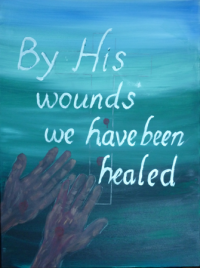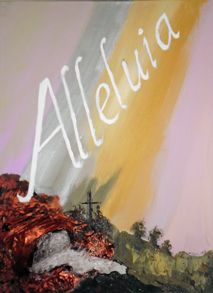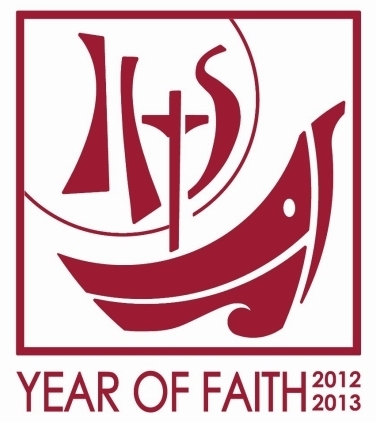Lenten Canvas:
By His wounds we have been healed

At first glance, from a distance, the words are prominent but they seem meaningless. They are a contradiction. Whose are the wounds that have healed and why did I need healing? There has been nothing wrong with me. I am healthy and strong. As I look further into the picture, I see the outstretched arms reaching up, hands wide open, palms upward, pleading, begging. They are like the hands of poor people on the streets: the tramps: the homeless: the hungry. But what has that got to do with me? I am not poor. I’m not rich but I have enough. I have a house and a family. I have enough to feed them and give them a few luxuries now and then. I am alright. I am comfortable with my life. They are not my hands reaching up, and yet, why do I feel uneasy?
As I approach the picture, I see that there is something behind the words. There is an outline of a cross, pieces of rough-cut wood put together to form a crucifix, but how can that be the answer to anything? The wood is dead. Once it was a tree, vibrant and strong: A tree that stood proud and produced fruit, food for people to eat, shade from the midday sun. Now it is dead. The shape is also a symbol of death, a cruel, hideous and shameful death of a criminal. I am drawn closer. There are two small red patches on the cross which represent the one who died. This must be the wondrous cross on which our saviour died.
Now I begin to feel remorse because I know that although my body may be whole, deep inside I am broken and sinful. I recall the sins that I have committed but more importantly perhaps, I remember the opportunities I have missed. I remember times when I have been “holier than thou”, but with all the advantages I have had, all the blessings our Heavenly Father has showered on me, I should be holy, but I am not. I turn away from the picture and look around at the people who are assembling for morning mass. I have come to know them so well and I am humbled by their faith and reverence before the Blessed Sacrament. These are the holy ones. As I become more aware of my own brokenness, I feel a deep sorrow for I know that it was because of my sins that He had to suffer and die.
I turn again towards the picture and suddenly I am filled with Joy. I realise that it was because of our broken humanity that He came to live and die for us. I remember the lesson that St. Paul taught us that in our weakness we are strongest. If we can recognise and accept our brokenness and turn to Him for forgiveness, then we are healed.
O Jesus, son of the living God, have mercy on me a sinner.
Picture by Joe Tunstall, Reflection by Tony Topping
Easter 2013
Easter Canvas:
The ‘Alleluia’

This acrylic is a sequel to our Lenten canvas which grew from the quotation given by Fr Ravi: ‘By His wounds we have been healed’. The dichotomy of wounds healing us helps us journey to the joy and appreciation of God’s love this Easter.
This Easter 2013 canvas also comes from the ‘Alleluia’ given by Fr Ravi as a starting point. It is intended to help us deepen our understanding of how much God loves us; we spend a long time in our life coming to terms with the concept of God’ love for us- unmerited, freely given and proven by Christ’s dreadful Passion, Death and wonderful Resurrection. How often does it challenge us to receive something for nothing?
The ‘Alleluia’ canvas shows God’s light of love rising above the dark earth of the garden containing Our Lord’s tomb- and the darkness of our ingratitude in our sins. The small red flowers represent the blood shed by our Saviour. The three trees on a rising horizon lead to the cross and are a reminder of the three falls Christ endured on His way to our salvation.
The white unfurled and empty shroud was inspired by the SVP Stations of the Cross recently this Lent. The white of salvation is echoed by the white letters rising towards Heaven and Christ’s Resurrection from his burial, making us the Easter people, fully redeemed.
Lord teach us how much You love us. Help us know this in our heart whenever we see a crucifix.
Joe Tunstall, March 2013
The Year of Faith
Year of Faith at St Winefride's, Neston During the Year of Faith the parish of St Winefride's have undertaken the following activities:
All about the Year of Faith in the Universal Church
Porta Fidei
This Year o
Why is the Year of Faith this year?
With his Apostolic Letter of October 11th, 2011, "Porta Fedei" - (The Door of Faith), Pope Benedict XVI declared that the Year of Faith would begin on October 11th 2012 and conclude on November 24th 2013. October 11th, the first day of the Year of Faith, was the fiftieth anniversary of the opening of the Second Vatican Council (Vatican II) and also the twentieth anniversary of the Catechism of the Catholic Church. During this Year of Faith Catholics are being asked to study and reflect on the documents of Vatican II and the Catechism so that they may deepen their knowledge of the faith.
How are the Year of Faith and New Evangelization linked?
How does the Year of Faith affect the average Catholic?
Every baptized Catholic is called through Baptism to be a disciple of Christ and proclaim the Gospel. The Year of Faith is an opportunity for each and every Catholic to renew their Baptismal call by living out the everyday moments of their lives with faith, hope and love. This everyday witness is necessary for proclaiming the Gospel to family, friends, neighbours and our society as a whole.
In order to witness to the Gospel, Catholics must be strengthened by acquiring a knowledge of their faith. Taking extra time to study the documents from the Second Vatican Council and by familiarizing themselves with the catechism in a more intense way. They must also seek strength by their participating in the Celebration of the Eucharist and the Sacrament of Reconciliation.
Parishes are encouraged to provide their parishioners with opportunities to deepen their faith during this special year, through retreats, special liturgies, Bible studies, service opportunities and formation sessions on the catechism and sacraments.
Year of Faith Vatican II Talks
In the Parish Hall (7:00pm refreshments, talks start at 7:30pm. Night prayer at 8:45pm). 2nd Thursday of every month. ALL WELCOME! October 11th Mgr Chris Lightbound The Church Then and Now November 8th Fr David Roberts Eucharistic Ecclesilogy
December 13th Canon Chris Walsh Liturgical Renewal
January 10th Fr Nick Kern Christian Unity February 14th Fr David Long Small Christian Communities March 13th Mrs Cecilia Allen The Laity within the Church April 11th Canon John O'Reilly The Word of God and the Signs of the Times
May 9th Canon John Marmion The Church in the Service of the World June 13th Fr Denis Marmion Jews and Christians
July 11th Canon Brendan Hoban The Church's Challenges and Hopes |


 The New Evangelization, which was called for by Blessed John Paul II, is a call to each Catholic to deepen his or her own faith, have confidence in the Gospel and possess a willingness to share this Gospel. The New Evangelization is first and foremost a personal encounter with Jesus; it is an invitation to deepen one's own relationship with Him and a call to each person to share his or her own faith with others, using all the modern media available to take this Gospel to the ends of the earth! The Year of Faith, just like the New Evangalization, is a calling to conversion in order to deepen our relationship with Christ and to share our faith with others.
The New Evangelization, which was called for by Blessed John Paul II, is a call to each Catholic to deepen his or her own faith, have confidence in the Gospel and possess a willingness to share this Gospel. The New Evangelization is first and foremost a personal encounter with Jesus; it is an invitation to deepen one's own relationship with Him and a call to each person to share his or her own faith with others, using all the modern media available to take this Gospel to the ends of the earth! The Year of Faith, just like the New Evangalization, is a calling to conversion in order to deepen our relationship with Christ and to share our faith with others.